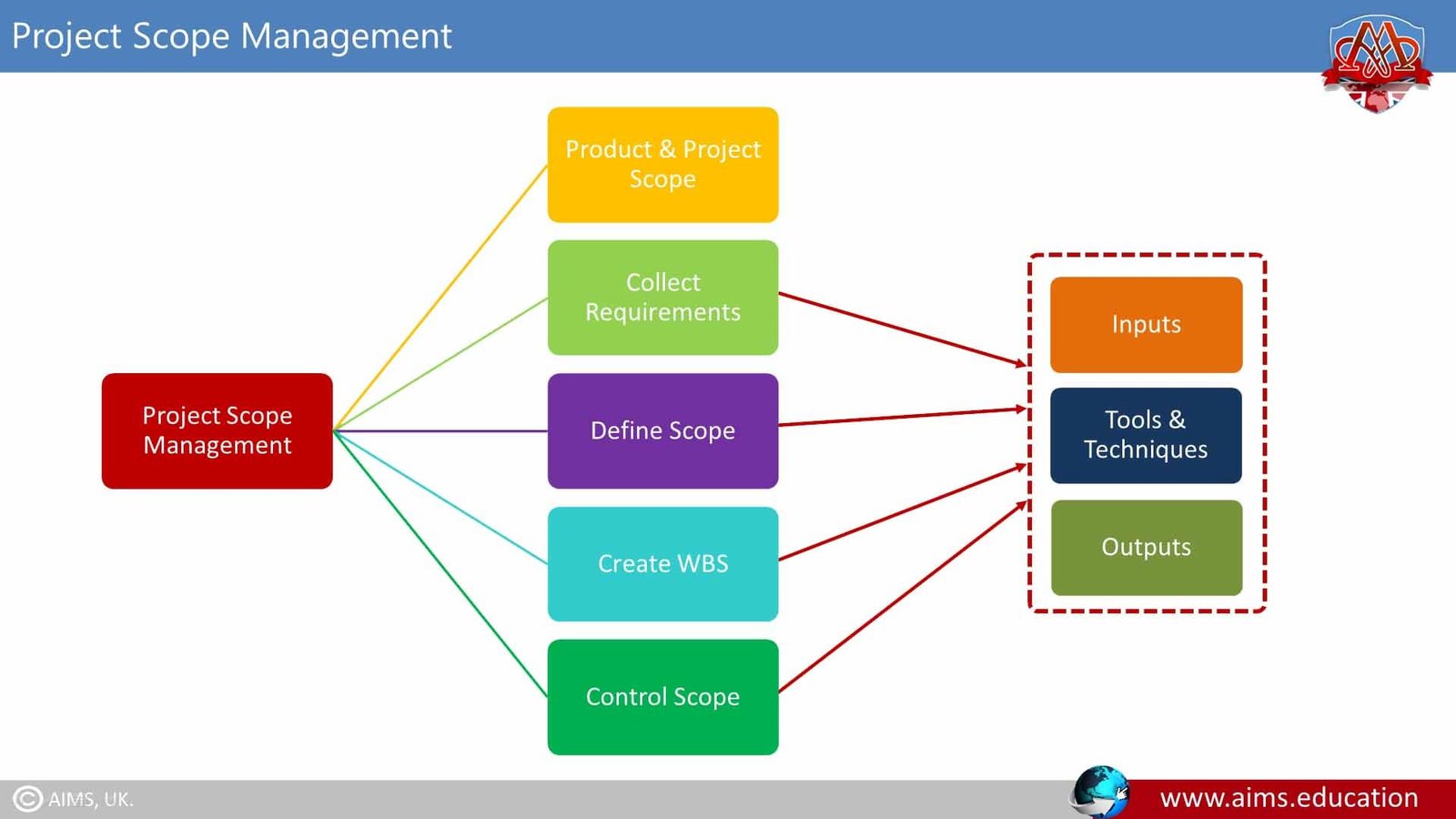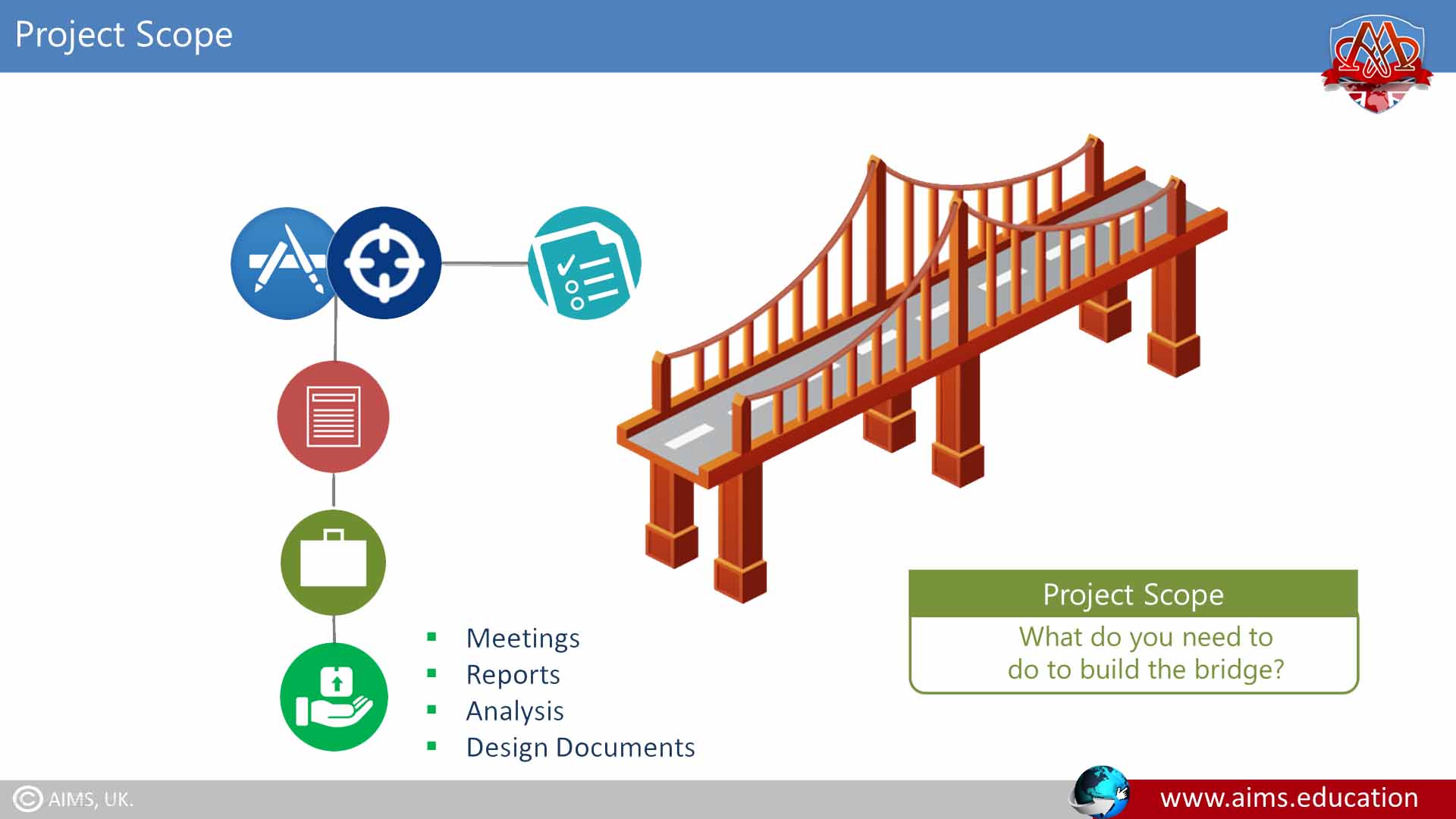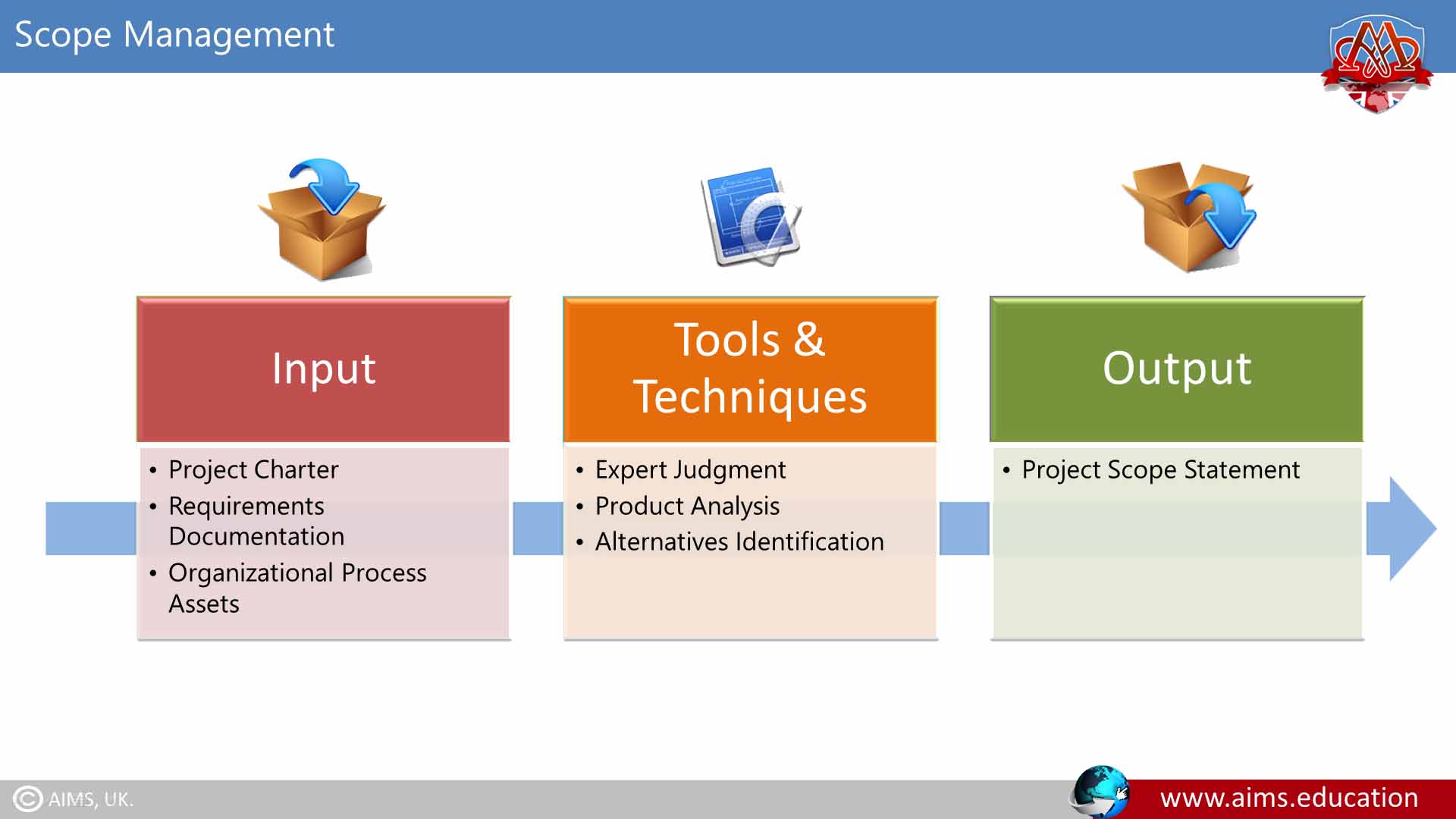What is the Project Scope Management?
Let’s solidify our understanding of what is project scope? Project scope management refers to all the work involved in creating the deliverables of the project and the processes used to create them. Scope of project management ensure that the project includes all the tasks required to complete the project successfully. Primarily the project scope concerned defining and controlling what is included and what is not.
Benefits of Defining the Project Scope
Here are the key benefits of defining the project scope:
- The project Focus is clear.
- Stakeholders are aligned on the objective and outcomes.
- Risk factors are in consideration.
- Resource requirements are obvious.
6 Steps to Define the Scope in Project Management
Here are the six key steps required to define the scope of the project:
- Step-1. Understand the Project Management Objectives.
- Step-2. Identify the Project Requirements.
- Step-3. Define the Project Boundaries.
- Step-4. Develop a Detailed Project Scope Statement.
- Step-5. Get Stakeholder Approval.
- Step-6. Review and Refine the Project Scope.
Product Scope VS Project Scope
What is Product Scope?
To understand what is project scope management, we describe product scope, which describes the product to be delivered –”what does the customer wants you to produce with the project?” The deliverables are products such as a new system, a new car, a new process, etc. Completion of the product is measured against product requirements that define the features or functions of the products.
What is Project Scope?
Project scope describes the work required to produce the project deliverables. The deliverables can be meetings, reports, analysis, design documents, etc. and all the parts of the agile project management or traditional project management that become part of the scope management plan. Completion is measured against the project scope management plan that is a subsidiary to the project management plan.
- Project Scope Statement: This statement provides a detailed description of the project’s objectives and the work required to achieve them.
- Scope Creep: This occurs when a new requirement is added to the project and is also referred to as “Uncontrolled Changes.” It mostly happens when the project is not clearly defined or documented.
Project Scope Management Example
The client comes and asks you to construct a school building for him. He gives you his requirements, such as the size of the school building, the number of rooms it will have, the size of the playground, the number of toilets, the color of the painting, when he needs it, etc. You take the project and start working on it. You make the plan, create the schedule, and estimate the budget.
Subsequently, you move on to the execution part. You bring workers to the site and start constructing the school building. You complete the project successfully and verify with the client that the school building meets his requirements. Then, you hand over the school building to the client, get the payment, and close the project.
The above example has two parts:
- In the first part, the client asks you to make a school building for him and gives you his requirements (characteristics). This school building is the Product, and the requirements for this product are known as the Scope. Therefore, what the client provided to you in the first part is the Product Scope.
- In the second part, you work to construct the school building within the given time and budget, meeting all the client’s requirements by following the project management plans. Lastly, you deliver it to the client. In this part, what you have done to construct the school building is the Project Scope.
Defining the project scope is critical to its success since it spells out exactly what the project’s product or service will be. Conversely, poor project scope definition, while finding what project scope management is, might lead to undisciplined budget, rework, schedule delays, and poor morale.

Project Scope Management Processes
Project Scope Collection Requirements
Collect Requirements is the first process in the Project Scope Management Knowledge Area. The purpose of Project Scope Management is to describe and control what is and is not the work of the project. This is the first process where we get into the meat of the planning processes and define what the final product or service of the project looks like—thus, we’re starting off defining what is included in the work of the project.
Significance of Project Scope
Requirements are typically conditions that must be met or criteria that the product or service of the project must possess to satisfy the objectives of the project. Requirements quantify and prioritize the project sponsor’s and stakeholders’ wants, needs, and expectations. The primary purpose of the Collect Requirements process is to define and document the project sponsor, the customer, and the stakeholder’s expectations and needs for fulfilling the project management principles and objective, as explained in the first part of the lecture, what is project scope management. Recording the requirements and attaining stakeholder approval of the requirements will help you define and manage their expectations throughout the project.
Enhance Skills by Mastering Project Management
AIMS’ flexible and online learning system has made obtaining a project management qualification in the UK easy, and it may be achieved anywhere in the world.
- The online project management certifications offer in-depth insight into project management and equip professionals with knowledge and skills.
- Similarly, the online diploma in project management allows students to master their skills in project management, program management, and project portfolio management.
- For professionals seeking senior roles, an online MBA in project management or a Project Management PhD are designed for advanced and flexible studies.

1. Project Scope Management Inputs
a. Scope Management Plan
The scope management plan clarifies how project teams will determine which requirements need to be collected for the project.
b. Stakeholder Management Plan
The stakeholder management plan is used to understand stakeholder communication requirements and the level of stakeholder engagement, as well as assess and adapt to the level of stakeholder participation in requirements activities.
c. Stakeholder Register
The stakeholder register is used to identify stakeholders who can provide information on the requirements. The stakeholder register also captures major requirements and main expectations stakeholders may have for the project.
2. Scope Management Tools and Techniques
There are several tools and techniques in this process you can use to help identify the requirements of the project. The following tools and techniques are used for Collect Requirements:
a. Interviews
Interviews are typically one-on-one conversations with stakeholders. Interviews can be formal or informal and generally consist of questions prepared beforehand. The advantages of this tool are that subject matter experts and experienced project participants can impart a lot of information quickly and typically have a good understanding of the features and functions needed from the project deliverables. You should record the responses during the interviews, and don’t be afraid to ask spontaneous questions as they occur to you during the interview.
b. Focus Groups
A trained moderator usually conducts focus groups. The key to this tool is selecting the subject matter experts and stakeholders to participate in the focus group.
c. Facilitated Workshops
Cross-functional stakeholders come together in a facilitated workshop to discuss and define multiple departments’ requirements. For example, suppose you’re implementing a software package that impacts several business units. In that case, you’ll need representatives from each unit together in a workshop so that each of their needs are represented and prioritized. In explaining project scope management, all the participants understand the various needs and have a facilitated forum to discuss and resolve their issues.
d. Group Creativity Techniques
Group creativity involves several techniques, such as brainstorming, Nominal group techniques, the Delphi technique, and affinity diagrams. We will cover each of these techniques in either the project cost management planning or project quality management process.
e. Idea/Mind Mapping
It is a group creativity technique in which participants first use brainstorming techniques to record their ideas. Whiteboards or flip charts are great tools for this process. The facilitator uses the whiteboard to map ideas and group similar topics together using a mind-mapping layout. A few mind-mapping project management software packages available on the market can greatly assist with this process. Mind mapping allows the participants to understand common ideas and themes, create new ideas, and understand differences.
f. Group Decision-Making Techniques
There are many methods groups can use to reach decisions. These methods can also be used with the group creativity techniques. The four methods mentioned include unanimity, where everyone agrees on the resolution or course of action; majority, where more than 50 percent of the members support the resolution; plurality, where the largest subgroup within the group decides if majority is not reached; and dictatorship, where one person makes the decision on behalf of the group.
g. Questionnaires and Surveys
This technique involves querying a large group of participants via questionnaires or surveys. Project manager responsibilities include gathering information quickly using these tools and applying statistical analysis, if needed, to the results.
h. Observations
This technique is typically a one-on-one experience where an observer sits with the participant to observe how the participant interacts with the product or service. It is also known as job shadowing. For example, you may use this technique to determine requirements for an upgrade to a software product. Sitting with the user and watching their interactions with the product enables the observer to uncover requirements they would not have ordinarily discovered. This technique can also involve participant observers who perform the job themselves to ascertain requirements.
i. Prototypes
Prototyping involves constructing a working model or mock-up of the final product for participants to experiment. The prototype does not usually contain all the functionality the end product does, but it gives participants enough information that they can provide feedback regarding the mock-up. This is an iterative process where participants experiment and provide feedback. The prototype is revised, and the cycle starts again. Below is one of the best way to explain what is project scope management.

3. Project Scope Statement and Project Document UPdate
You’ve worked hard to gather and define requirements and don’t want all that effort to go to waste. Now that you’ve employed the tools and techniques of this process to gather requirements, you’ll want to record them in a requirements document. This involves recording the requirements in a requirements document.
The PMBOK® Guide does not dictate the format of this document and acknowledges it can be formal with lots of detail or a simple list categorized by stakeholder and priority. However, it does state that the requirements document may include at least the following elements:
- What are the business needs for the project, and why was it undertaken?
- Objectives of the project and the business objectives the project hopes to fulfill.
- Functional requirements.
- Non-functional requirement.
- Project quality management requirements.
- Acceptance criteria.
- Organizational areas and outside entities impacted.
- Support and training requirements.
- Assumptions and constraints.
- Signatures of the key stakeholders indicating their acceptance of the requirements. Their approval is essential for successful project management.
Project Scope Template
The Project Scope statement usually covers the following:
- Project Overview.
- Project Deliverables.
- Project Exclusions.
- Project Constraints.
- Project Assumptions.
- Project Risks.
- Project Approved Changes.
Final Words
- Scope management in project management is pivotal for effective project execution.
- A comprehensive project scope statement outlines the project goals, the work breakdown structure (WBS), and the project budget.
- Managing scope is a key to avoiding scope creep.
- Project management scope drives successful outcomes and keeps the project within the defined boundaries.
